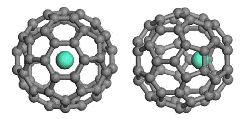Chemistry, Department of: Faculty Series

Xiao Cheng Zeng Publications
Document Type
Article
Date of this Version
10-1-2005
Abstract
It has been established from experiments that stable medium-sized ionic clusters Si15–Si20 are prolate in shape. Density-functional theories (DFTs) also predict that nearly all low-lying neutral clusters in this size range are prolate in shape. Moreover, most of them are built onto two generic structural motifs, either the tricapped-trigonal-prism (TTP) Si9 motif or the six/six Si6/Si6 (sixfold-puckered hexagonal ring Si6 plus six-atom tetragonal bipyramid Si6) motif. However, it appears that the exact location of the TTP-to-six/six motif transition is dependent on the functional (e.g., PBE or BLYP) used in the DFT calculations. Here, we present total-energy calculations for two series of clusters (one series containing six/six motif and the other containing the TTP motif) in the size range of Si16–Si20. The calculations were based on all-electron DFT methods with a medium [6-311G (2d)] and a large (cc-pVTZ) basis sets, as well as coupled-cluster single and double substitutions (including triple excitations) [CCSD(T)] method with a modest (cc-pVDZ) basis set. In the DFT calculations, two popular hybrid density functionals, the B3LYP and PBE1PBE, were selected. It is found that the B3LYP total-energy calculations slightly favor the six/six motif, whereas the PBE1PBE calculations slightly favor the TTP motif. The CCSD(T) total-energy calculations, however, show that isomers based on the six/six motif are energetically slightly favorable in the size range of Si16-Si20. Hence, the TTP-to-six/six motif transition is more likely to occur at Si16.


Comments
Published by American Institute of Physics. J. Chem. Physics 123, 164303 2005. ©2005 American Institute of Physics. Permission to use. http://jcp.aip.org/.